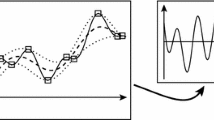Abstract
Biomedical signals are in general non-linear and non-stationary. empirical mode decomposition in conjunction with a Hilbert-Huang Transform provides a fully adaptive and data-driven technique to extract intrinsic mode functions. The latter represent a complete set of locally orthogonal basis functions to represent non-linear and non-stationary time series. Large scale biomedical time series necessitate an online analysis, which is presented in this contribution. It shortly reviews the technique of EMD and related algorithms, discusses the recently proposed weighted sliding EMD algorithm (wSEMD) and, additionally, proposes a more sophisticated implementation of the weighting process. As an application to biomedical signals we will show that wSEMD in combination with mutual information could be used to detect temporal correlations of arterial blood pressure and intracranial pressure monitored at a neurosurgical intensive care unit. We will demonstrate that the wSEMD technique renders itself much more flexible than the Fourier based method used in Faltermeier et al. (Acta Neurochir Suppl, 114, 35–38, 2012).










Similar content being viewed by others
References
Brawanski A, Faltermeier R, Rothoerl RD, Woertgen C (2002) Comparison of near-infrared spectroscopy and tissue pO\(_2\) time series in patients after severe head injury and aneurysmal subarachnoid hemorrhage. J Cereb Blood Flow Metab 22:605–611
Cover T, Thomas J (1991) Elements of information theory. Wiley, New York
Faltermeier R, Zeiler A, Keck IR, Tomé AM, Brawanski A, Lang EW (2010) Sliding empirical mode decomposition. In: Proceedings of the IEEE WCCI-IJCNN 2010. IEEE.
Faltermeier R, Zeiler A, Tomé, AM, Brawanski A, Lang EW (2011) Weighted sliding empirical mode decomposition. Adv Adapt Data Anal 3:509
Faltermeier R, Proescholdt MA, Brawanski A (2012) Computerized data analysis of neuromonitoring parameters identifies patients with reduced cerebral compliance as seen on CT. Acta Neurochir Suppl 114:35–38
Huang NE, Shen Z, Long SR, Wu ML, Shih HH, Zheng Q, Yen NC, Tung CC, Liu HH (1998) The empirical mode decomposition and hilbert spectrum for nonlinear and nonstationary time series analysis. Proc R Soc Lond A 454:903–995
Jung A, Faltermeier R, Rothoer R, Brawanski A (2005) A mathematical model of cerebral circulation and oxygen supply. J Math Biol 51(5):491–507
Lang EW, Schachtner R, Lutter D, Herold D, Kodewitz A, Blöchl F, Theis FJ, Keck IR, Saez JMG, Vilda PG, Tomé AM (2011) Exploratory matrix factorization techniques for large scale biomedical data sets, chap 2. Bentham Publishers, Oak Park, pp 26–47
Quiroga RQ, Arnhold J, Grassberger P (2000) Learning driver-response relationships from synchronization patterns. Phys Rev E 61:5142
Quiroga RQ, Kraskov A, Kreuz T, Grassberger P (2002) Performance of different synchronization measures in real data: a case study on electroencephalographic signals. Phys Rev E 65:041903
Wu Z, Huang N (2009) Ensemble empirical mode decomposition: a noise assisted data analysis method. Adv Adapt Data Anal 1:1–41
Zeiler A, Faltermeier R, Böhm M, Keck IR, Tomé AM, Puntonet CG, Brawanski A, Lang EW (2010) Empirical mode decomposition techniques for biomedical time series analysis, chap 4. Bentham Publishers, Oak Park, pp 60–81
Zeiler A, Faltermeier R, Keck IR, Tomé AM, Brawanski A, Puntonet CG, Lang EW (2010) Brain staus data analyzed by empirical mode decomposition. In: Proceedings of the IEEE WCCI-IJCNN 2010. IEEE
Acknowledgments
Financial support by the DAAD-FCT is gratefully acknowledged.
Author information
Authors and Affiliations
Corresponding author
Rights and permissions
About this article
Cite this article
Zeiler, A., Faltermeier, R., Tomé, A.M. et al. Weighted Sliding Empirical Mode Decomposition for Online Analysis of Biomedical Time Series. Neural Process Lett 37, 21–32 (2013). https://doi.org/10.1007/s11063-012-9270-9
Published:
Issue Date:
DOI: https://doi.org/10.1007/s11063-012-9270-9




